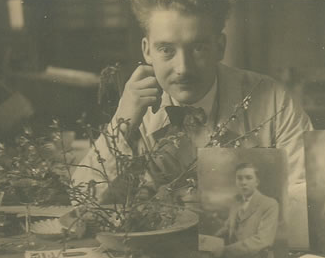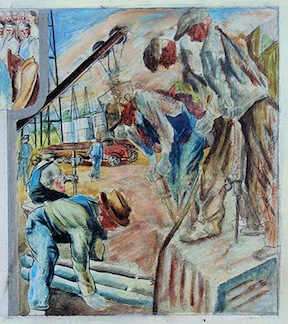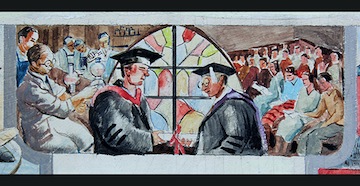Difference between revisions of "Joseph Paul Vorst: Mormon Artist"
(Created page with "300px|thumb|alt=Joseph Vorst Mormon Artist|right '''Joseph Paul Vorst''' was an award-winning artist. He was born in 1897 in Essen, Germany and beg...") |
|||
| (One intermediate revision by the same user not shown) | |||
| Line 3: | Line 3: | ||
'''Joseph Paul Vorst''' was an award-winning artist. He was born in 1897 in Essen, Germany and began his career as a printmaker and commercial illustrator, then moved into fine art. He studied at the National Academy of Berlin and other elite art schools in Germany. He served in World War I, where he was injured and had a lame leg for the rest of his life. | '''Joseph Paul Vorst''' was an award-winning artist. He was born in 1897 in Essen, Germany and began his career as a printmaker and commercial illustrator, then moved into fine art. He studied at the National Academy of Berlin and other elite art schools in Germany. He served in World War I, where he was injured and had a lame leg for the rest of his life. | ||
| − | Vorst joined [http:// | + | Vorst joined [http://comeuntochrist.org The Church of Jesus Christ of Latter-day Saints] in 1924. He helped the Church grow in Germany and later Missouri. He emigrated from Germany at the rise of the Nazi party and settled near relatives in St. Louis, Missouri. The Improvement Era reported that Vorst chose to live in Missouri because of its association in LDS belief with [[Adam-ondi-Ahman]], the place where Adam and Eve dwelt after they left the Garden of Eden.[https://www.lds.org/church/news/church-acquires-art-of-unsung-lds-artist-joseph-paul-vorst?lang=eng] He then traveled to Salt Lake City to go to the [[Salt Lake Temple]]. He made a brief trip back to Germany before returning to Missouri, where he became friends with artist Thomas Hart Benton. They shared an interest in painting landscapes with people harvesting crops, plowing fields, and raising families. They were part of the art movement of the 1930s known as Regionalism, which reacted against rapidly developing technology and city life. Other well-known artists of this movement included Grant Wood and John Steuart Curry. |
Vorst became known as “one of the finest of all Midwestern portrayers of the American scene.”[https://www.lds.org/church/news/church-acquires-art-of-unsung-lds-artist-joseph-paul-vorst?lang=eng] | Vorst became known as “one of the finest of all Midwestern portrayers of the American scene.”[https://www.lds.org/church/news/church-acquires-art-of-unsung-lds-artist-joseph-paul-vorst?lang=eng] | ||
| Line 19: | Line 19: | ||
Vorst was director of art at Jefferson College in St. Louis and created small editions of lithographs of his work. He died from an aneurysm in 1947. He had married and was the father of one son. | Vorst was director of art at Jefferson College in St. Louis and created small editions of lithographs of his work. He died from an aneurysm in 1947. He had married and was the father of one son. | ||
| − | [[Category:Mormon Life and Culture]] | + | [[Category:Mormon Life and Culture]][[Category:Famous Mormons]] |
| + | {{DEFAULTSORT:Vorst, Joseph Paul}} | ||
Latest revision as of 14:03, 31 July 2021
Joseph Paul Vorst was an award-winning artist. He was born in 1897 in Essen, Germany and began his career as a printmaker and commercial illustrator, then moved into fine art. He studied at the National Academy of Berlin and other elite art schools in Germany. He served in World War I, where he was injured and had a lame leg for the rest of his life.
Vorst joined The Church of Jesus Christ of Latter-day Saints in 1924. He helped the Church grow in Germany and later Missouri. He emigrated from Germany at the rise of the Nazi party and settled near relatives in St. Louis, Missouri. The Improvement Era reported that Vorst chose to live in Missouri because of its association in LDS belief with Adam-ondi-Ahman, the place where Adam and Eve dwelt after they left the Garden of Eden.[1] He then traveled to Salt Lake City to go to the Salt Lake Temple. He made a brief trip back to Germany before returning to Missouri, where he became friends with artist Thomas Hart Benton. They shared an interest in painting landscapes with people harvesting crops, plowing fields, and raising families. They were part of the art movement of the 1930s known as Regionalism, which reacted against rapidly developing technology and city life. Other well-known artists of this movement included Grant Wood and John Steuart Curry. Vorst became known as “one of the finest of all Midwestern portrayers of the American scene.”[2]
As part of the Federal Art Project under the U.S. government’s Works Project Administration, Vorst created works for public buildings and posters to help spread patriotism during World War II.
Vorst exhibited at the Metropolitan Museum of Art, the Whitney Museum, the Washington Corcoran Gallery, the Art Institute of Chicago, the Corporate Gallery, the San Francisco Museum, the Carnegie Institute, the Library of Congress, the World’s Fair, the Smithsonian, and the White House. He was well known and celebrated in the art world, but was and is not as well known within the world of LDS artists.
Some of his work hinted of his LDS beliefs. In November 2014, the Church History Department acquired a large portion of his works from his estate. The LDS Church acquired one of Vorst’s lithographs entitled, “Joe and His Mission,” which might look like any farm boy, but members of the Church knowing Vorst’s deep commitment to his testimony of the gospel will easily recognize the connection to Joseph Smith.
Vorst was director of art at Jefferson College in St. Louis and created small editions of lithographs of his work. He died from an aneurysm in 1947. He had married and was the father of one son.


